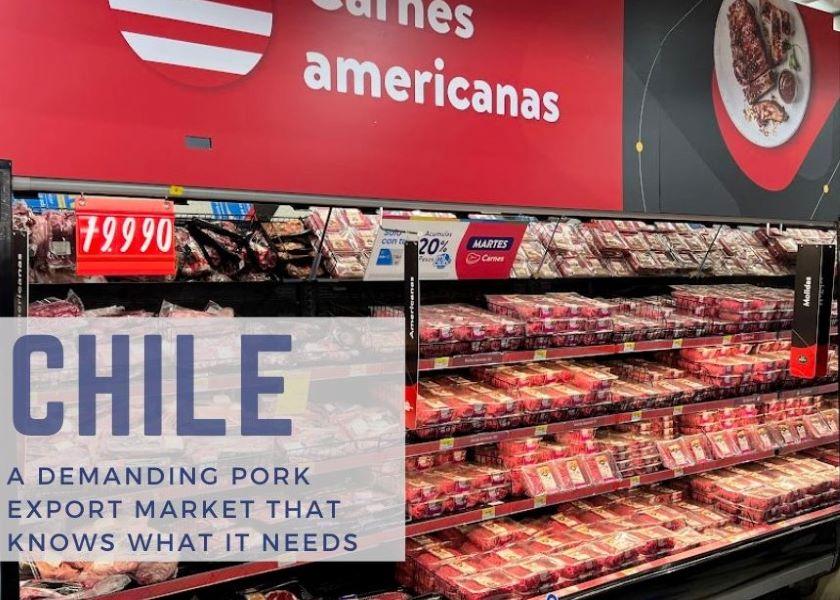Chile: A Demanding Pork Export Market That Knows What It Needs

Despite strong growth in both production and imports, total pork consumption in Chile has fluctuated at the same level over the last decade, and fallen in per capita terms, Gira writes in its latest report on Chile in a series initiated by the National Pork Board that’s focused on differentiation of U.S. pork in key international markets.
Why? Despite positive demand factors in population growth and economic development, exports of pork continue to keep the market short, the report says.
“Chile’s pork sector is modern, highly consolidated and export-oriented, factors that U.S. exporters should bear in mind. Export replacement is a major function of the import market, leading to big up-and-down swings in import demand, as it backfills for fluctuating exports,” the report says.
Because slow economic and consumption growth are expected in the mid-term, demand for imported pork will continue to depend on the success of Chile’s pork exports, Gira points out.
“Chile will continue to need imported pork, with volumes depending on Chile’s exports to China. Buyers will remain focused on price, especially for further processing, and will trust their relationships inside companies. Economic and currency stabilization will help here. The U.S. is well positioned to supply Chile’s frozen pork market and provide volume at consistent quality. Brazil is the main competitor, but the overall U.S. value proposition is superior in the long term,” Gira summarizes.
Here are five things for the U.S. pork industry to consider to improve export opportunities in Chile:
1. Price. Price is a reigning criterion as one would expect. However, Gira says it’s reinforced in Chile’s case by two factors: much of the import market goes to processors, who are especially price-conscious; and because much of the demand is for backfill imports, they must be much cheaper than Chile’s export products. Unfortunately, price is something U.S. exporters can’t control – since inflation and the USD/CLP exchange rate are key factors.
2. Relationships. Personal contact with a named individual is of high importance to Chileans and has helped expand their trade in Asia. This is one the most important aspects in the trade today (once price and quality known), as Chilean buyers usually have a closed pool of suppliers, Gira explains.
“Building relationships will help support U.S. sales initiatives. This will require a consistent account manager who deals with specific people in Chile, an online portal if possible, for tracking shipments and document transfer and attending conferences, sponsoring U.S. visits,” the report says.
3. Speed. Although Brazil’s speed advantage is unbeatable, it’s important for U.S. suppliers to reduce time lags regardless.
“The industry is unanimous that U.S. provides better quality, and a substantial reduction in timing would help make the time-to-market issue less important,” Gira says. “Container and shipping backlogs appear to be easing, so that should help; U.S. suppliers can help by speeding the sequence from order to production to U.S. port of embarkation.”
4. Services. Gira found that importers are prepared to pay for high quality pork depending on the country of origin, the cut needed and the additional services negotiated. Services, including labeling, packaging control, order traceability, etc., will differentiate the offer in the future and lock buyers to U.S. exporters.
5. Sustainability. It may not be a high priority now, but Gira believes it will be in the next three to five years. U.S. exporters will have to develop recyclable packaging (not just for Chile), and demonstrate commitment to traceability, environmental impact and animal welfare. This is an opportunity for the U.S. to get ahead of the game by being first-to-market with credible support for these kinds of claims.
“You have to compete on the strengths of the U.S. industry – the quality, consistency, and all the things that go behind that, whether that's sustainability or whether that's the fact that you supply the right product at the right time and do more effort around that to hold market share,” says Rupert Claxton, meat director at Gira. “It’s not just about having a very cheap product that you can push into the market, but encouraging that market to want to pull it.”
Request a copy of the report on porkcheckoff.org.
Learn more:
Colombia and Chile Offer Untapped Potential for U.S. Pork Industry







